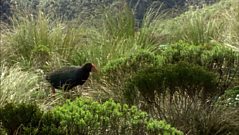
Clawed wings
Hoatzin chicks show us how archaeopteryx may have used its wing hooks to climb.
The fossil of an ancient bird called Archaeopteryx shows that it was well-equipped for climbing. Its wings had three fingers, each ending with a hooked claw that was perfect for clinging onto twigs. Today, in the swamps of South America, the chicks of the Hoatzin have wing-claws too. They start clambering about the nest when they are only a few days old, so the hooks on the front limbs are very useful to help keep it secure until the claws develop into feathered and reliable wings. Archaeopteryx probably used its claws in much the same way. If disaster strikes and the hoatzin chicks fall into the swamp, the wing-claws can help them climb back out. When the mother returns from her trip away, she will have fed on leaves and have a full crop, so there may be some for the chick. Like all modern birds, the hoatzin does not have a bony jaw like Archaeopteryx but has a lightweight beak instead. The fossil of a bird found in China is a little younger than Archaeopteryx but seems to show that the change from bony jaw to lightweight beak must have happened very quickly and must have made flight much more efficient. It would have prevented the bird from being nose-heavy and significantly reduced its overall weight.
Duration:
This clip is from
Featured in...
![]()
成人快手 Nature
Be captivated, informed and inspired by the world's wildlife.
More clips from To Fly or Not to Fly?
-
![]()
Weka Territory
Duration: 01:08
-
![]()
Feet on the ground
Duration: 00:51
-
![]()
Bat buffet
Duration: 03:09
-
![]()
Back from the brink
Duration: 02:17
More clips from The Life of Birds
-
![]()
Weka Territory—To Fly or Not to Fly?
Duration: 01:08
-
![]()
Feet on the ground—To Fly or Not to Fly?
Duration: 00:51
-
![]()
Thirst quencher—The Limits of Endurance
Duration: 03:10
-
![]()
Food on the run—Meat-Eaters
Duration: 02:12








